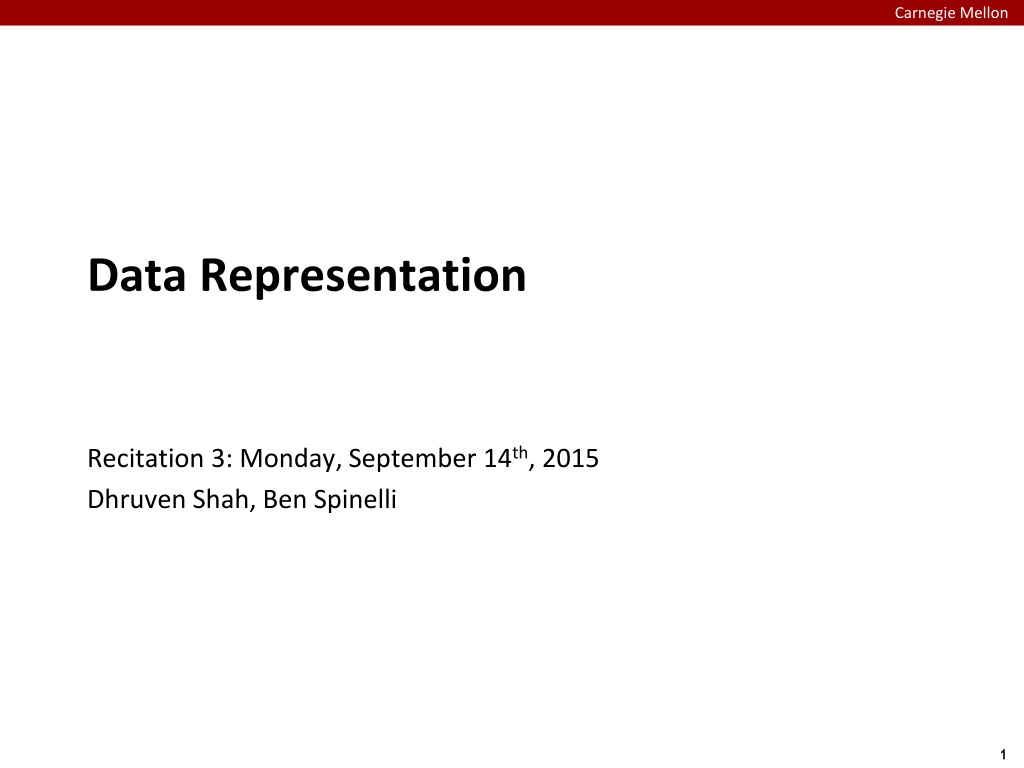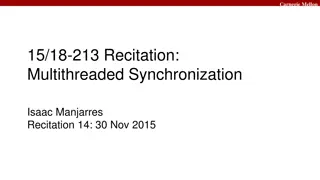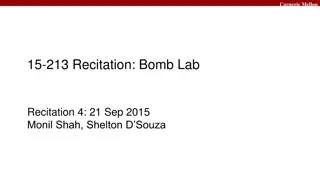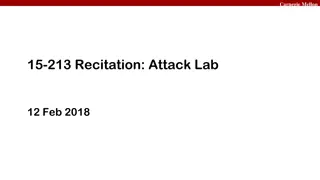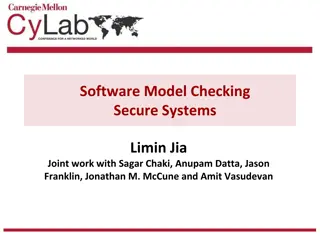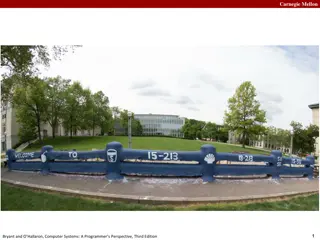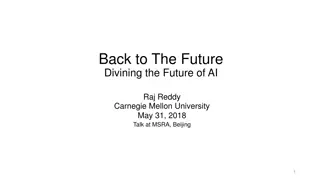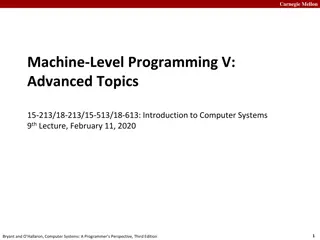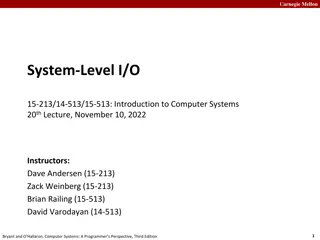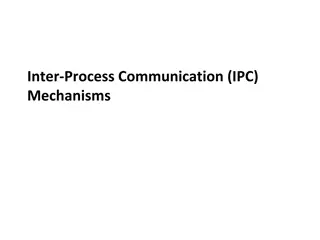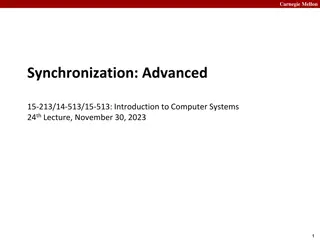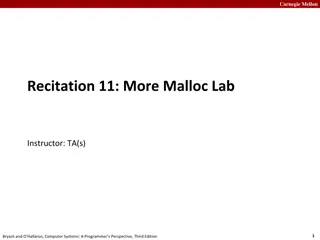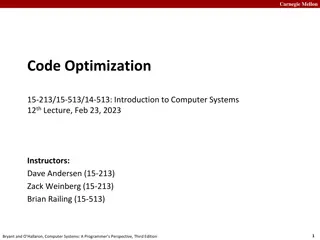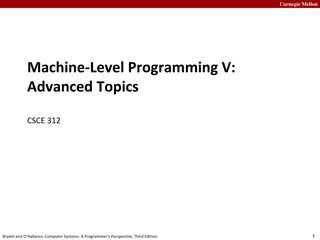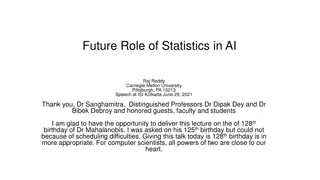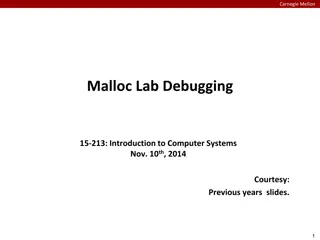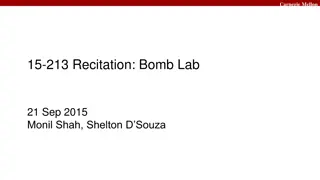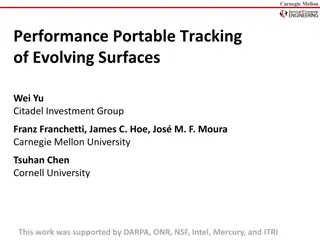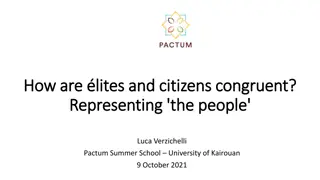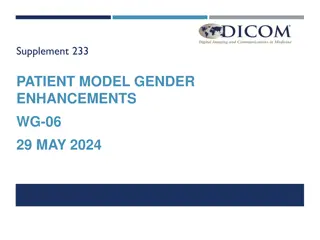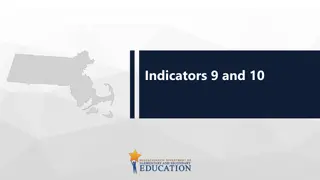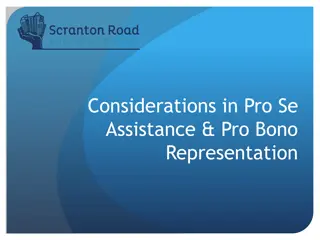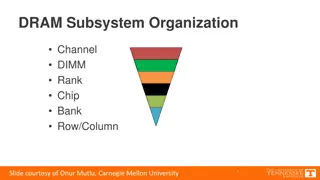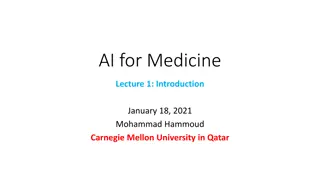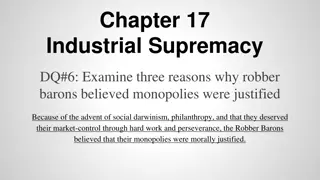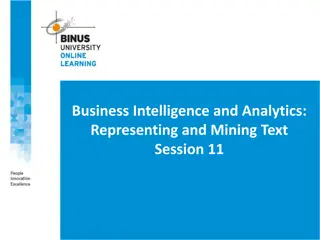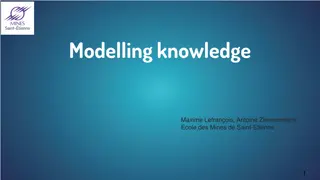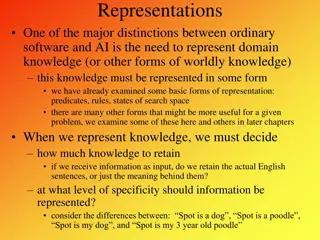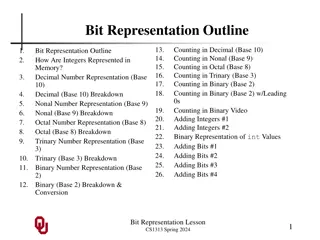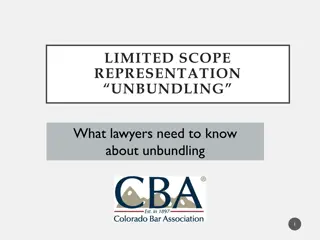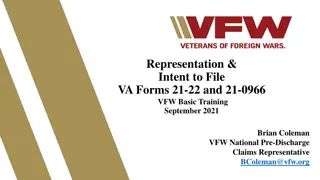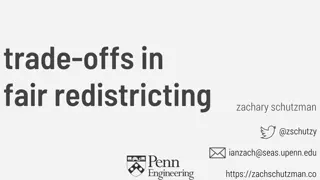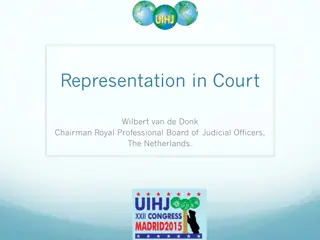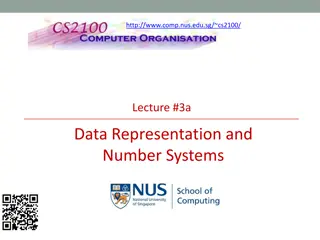Carnegie Mellon Data Representation Recitation Details
Carnegie Mellon's data representation recitation provides a platform for interaction, addressing topics like integers, biasing, endianness, floating point, binary fractions, and the IEEE standard. The agenda includes steps on how to approach the data lab, emphasizing the importance of working on designated machines, testing solutions, and submitting work correctly. Helpful tips and guidelines are also provided for successful completion of the lab assignments.
Download Presentation

Please find below an Image/Link to download the presentation.
The content on the website is provided AS IS for your information and personal use only. It may not be sold, licensed, or shared on other websites without obtaining consent from the author. Download presentation by click this link. If you encounter any issues during the download, it is possible that the publisher has removed the file from their server.
E N D
Presentation Transcript
Carnegie Mellon Data Representation Recitation 3: Monday, September 14th, 2015 Dhruven Shah, Ben Spinelli 1
Carnegie Mellon Welcome to Recitation Recitation is a place for interaction If you have questions, please ask. If you want to go over an example not planned for recitation, let me know. We ll cover: A quick recap of topics from class, especially ones we have found students struggled with in the past Example problems to reinforce those topics and prepare for exams Demos, tips, and questions for labs 2
Carnegie Mellon News Course Website: www.cs.cmu.edu/~213 Access to Autolab Office hours in GHC 5207 Sunday Thursday 6:00-9:00 pm Additional office hours near due dates, see website for schedule Linux boot camp this Saturday, 2:00-4:00 pm in Gates 4401 Data lab due September 17, 11:59 pm EDT 3
Carnegie Mellon Agenda How do I Data Lab? Integers Biasing division Endianness Floating point Binary fractions IEEE standard Example problem 4
Carnegie Mellon How do I Data Lab? Step 1: Download lab files All lab files are on Autolab Remember to also read the lab handout ( view writeup link) Step 2: Work on the right machines Remember to do all your lab work on Andrew or Shark machines Some later labs will restrict you to just the shark machines (bomb lab, for example) This includes untaring the handout. Otherwise, you may lose some permissions bits If you get a permission denied error, try chmod +x filename 5
Carnegie Mellon How do I Data Lab? Step 3: Edit and test bits.c is the file you re looking for Remember you have 3 ways to test your solutions. btest dlc BDD checker driver.pl runs the same tests as Autolab Step 4: Submit Unlimited submissions, but please don t use Autolab in place of driver.pl Must submit via web form To package/download files to your computer, use tar -cvzf out.tar.gz in1 in2 and your favorite file transfer protocol 6
Carnegie Mellon How do I Data Lab? Tips Write C like it s 1989 Declare variable at top of function Make sure closing brace ( } ) is in 1stcolumn We won t be using the dlc compiler for later labs Be careful of operator precedence Do you know what order ~a+1+b*c<<3*2 will execute in? Neither do I. Use parentheses: (~a)+1+(b*(c<<3)*2) Take advantage of special operators and values like !, 0, and Tmin Reducing ops once you re under the threshold won t get you extra points. Undefined behavior Like shifting by >31. See Anita s rant. 7
Carnegie Mellon Anita s Rant From the Intel x86 Reference: These instructions shift the bits in the first operand (destination operand) to the left or right by the number of bits specified in the second operand (count operand). Bits shifted beyond the destination operand boundary are first shifted into the CF flag, then discarded. At the end of the shift operation, the CF flag contains the last bit shifted out of the destination operand. The destination operand can be a register or a memory location. The count operand can be an immediate value or register CL. The count is masked to five bits, which limits the count range to 0 to 31. A special opcode encoding is provided for a count of 1. 8
Carnegie Mellon Integers - Biasing Can multiply/divide powers of 2 with shift Multiply: Left shift by k to multiply by 2k Divide: Right shift by k to divide by 2k for positive numbers Shifting rounds towards -inf, but we want to round to 0 Solution: biasing when negative 9
Carnegie Mellon Integers Endianness Endianness describes which bit is most significant in a binary number You won t need to work with this until bomb lab Big endian: First byte (lowest address) is the most significant This is how we typically talk about binary numbers Little endian: First byte (lowest address) is the least significant Intel x86 (shark/andrew linux machines) implement this 10
Carnegie Mellon Floating Point Fractions in Binary 2i 2i-1 4 2 1 bi bi-1 b2 b1 b0 b-1 b-2 b-3 b-j 1/2 1/4 1/8 2-j Representation Bits to right of binary point represent fractional powers of 2 Represents rational number: 11
Carnegie Mellon Floating Point IEEE Standard Single precision: 32 bits s exp frac 1 8-bits 23-bits Double precision: 64 bits s exp frac 1 11-bits 52-bits Extended precision: 80 bits (Intel only) s exp frac 1 15-bits 63 or 64-bits 12
Carnegie Mellon Floating Point IEEE Standard What does this mean? We can think of floating point as binary scientific notation IEEE format includes a few optimizations to increase range for our given number of bits The number represented is essentially (sign * frac * 2exp) There are a few steps I left out there Example: Assume our floating point format has no sign bit, k = 3 exponent bits, and n=2 fraction bits What does 10010 represent? 13
Carnegie Mellon Floating Point IEEE Standard What does this mean? We can think of floating point as binary scientific notation IEEE format includes a few optimizations to increase range for our given number of bits The number represented is essentially (sign * frac * 2exp) There are a few steps I left out there Example: Assume our floating point format has no sign bit, k = 3 exponent bits, and n=2 fraction bits What does 10010 represent? 3 14
Carnegie Mellon Floating Point IEEE Standard Bias exp is unsigned; needs a bias to represent negative numbers Bias = 2k-1 - 1, where k is the number of exponent bits Can also be thought of as bit pattern 0b011 111 Normalized Denormalized exp = 0 Implied leading 1 E = exp - Bias Denser near origin Represents small numbers When converting frac/int => float, assume normalized until proven otherwise 15
Carnegie Mellon Floating Point IEEE Standard Bias exp is unsigned; needs a bias to represent negative numbers Bias = 2k-1 - 1, where k is the number of exponent bits Can also be thought of as bit pattern 0b011 111 Normalized Denormalized 0 < exp < (2k-1) exp = 0 Implied leading 1 Leading 0 E = exp - Bias E = 1 - Bias. Why? Denser near origin Evenly spaced Represents large numbers Represents small numbers When converting frac/int => float, assume normalized until proven otherwise 16
Carnegie Mellon Floating Point IEEE Standard Special Cases (exp = 2k-1) Infinity Result of an overflow during calculation or division by 0 exp = 2k-1, frac = 0 Not a Number (NaN) Result of illegal operation (sqrt(-1), inf inf, inf * 0) exp = 2k-1, frac != 0 Keep in mind these special cases are not the same 17
Carnegie Mellon Floating Point IEEE Standard Round to even Why? Avoid statistical bias of rounding up or down on half. How? Like this: truncate 1.01002 1.012 below half; round down 1.01012 1.012 interesting case; round to even 1.01102 1.102 above half; round up 1.01112 1.102 truncate 1.10002 1.102 below half; round down 1.10012 1.102 Interesting case; round to even 1.10102 1.102 above half; round up 1.10112 1.112 truncate 1.11002 1.112 18
Carnegie Mellon Rounding 1.BBGRXXX Guard bit: LSB of result Sticky bit: OR of remaining bits Round bit: 1st bit removed Round up conditions Round = 1, Sticky = 1 > 0.5 Guard = 1, Round = 1, Sticky = 0 Round to even Value Fraction 128 1.0000000 15 1.1010000 100 17 1.0001000 010 19 1.0011000 110 138 1.0001010 63 1.1111100 111 GRS 000 N N Y 011 Y Incr? N 1.101 1.000 1.010 Y 10.000 Rounded 1.000 1.001 19
Carnegie Mellon Floating Point Example Consider the following 5 bit floating point representation based on the IEEE floating point format. This format does not have a sign bit it can only represent nonnegative numbers. There are k=3 exponent bits. There are n=2 fraction bits. 4 exp 3 2 1 frac 0 What is the Bias? Largest denormalized number? Smallest normalized number? Largest finite number it can represent? Smallest non-zero value it can represent? 20
Carnegie Mellon Floating Point Example Consider the following 5 bit floating point representation based on the IEEE floating point format. This format does not have a sign bit it can only represent nonnegative numbers. There are k=3 exponent bits. There are n=2 fraction bits. 4 exp 3 2 1 frac 0 What is the Bias? 0112 = 3 Largest denormalized number? 000 112 = 0.00112 = 3/16 Smallest normalized number? 001 002 = 0.01002 = 1/4 Largest finite number it can represent? 110 112 = 1110.02 = 14 Smallest non-zero value it can represent? 000 012 = 0.00012 = 1/16 21
Carnegie Mellon Floating Point Example For the same problem, complete the following table: Value Floating Point Bits Rounded Value 9/32 8 9 000 10 19 22
Carnegie Mellon Floating Point Example For the same problem, complete the following table: Value Floating Point Bits Rounded Value 9/32 1/4 001 00 8 8 110 00 9 8 110 00 1/8 000 10 19 inf 111 00 23
Carnegie Mellon Floating Point Recap Floating point = (-1)s M 2E MSB is sign bit s Bias = 2(k-1) 1 (k is num of exp bits) Normalized (larger numbers, denser towards 0) exp 000 0 and exp 111 1 M = 1.frac E = exp - Bias Denormalized (smaller numbers, evenly spread) exp = 000 .0 M = 0.frac E = - Bias + 1 24
Carnegie Mellon Floating Point Recap Special Cases +/- Infinity: exp = 111 1 and frac = 000 0 +/- NaN: exp = 111 1 and frac 000 0 +0: s = 0, exp = 000 0 and frac = 000 0 -0: s = 1, exp = 000 0 and frac = 000 0 Round towards even when half way (lsb of frac = 0) 25
Carnegie Mellon Questions? 26
